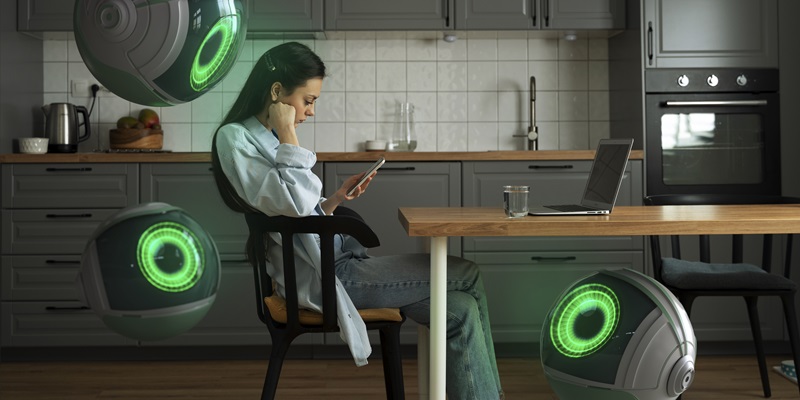The dream of an automated home is closer than ever, fueled by leaps in AI and robotics. What was once the stuff of sci-fi is now unfolding as domestic robots start to become household staples. A decade ago, the concept seemed distant, but today’s AI progress is turning our homes into hubs of tech ingenuity. These advancements are significant, turning homes into more than just shelters – they’re evolving into smart, technologically-driven environments. With each passing day, the fusion of sophisticated AI with home robotics is closer to bringing a new era of convenience and innovation into our daily domestic lives. This integration promises a future where technology is seamlessly woven into the fabric of our home life, offering unprecedented automation and efficiencies.
The Advent of Domestic AI
The initial forays into home automation have been relatively basic, revolving around voice-command devices and pre-programmed appliances. However, the frontier of domestic robotics is expanding rapidly, with AI at the helm. These robots are starting to capitalize on the potential to learn from their environment, make decisions, and execute tasks with greater precision and autonomy. The allure of a home robot that can understand and anticipate the needs of its inhabitants is not just about convenience but also a profound change in our interaction with technology. These robots, armed with the power of AI, hold the promise of transforming mundane chores into effortless tasks.
In previous decades, the concept of AI-powered robots in our homes was a distant dream, largely due to the limitations in technology. Today, breakthroughs in machine learning algorithms, coupled with improvements in sensor and actuator technology, are bringing that dream to life. AI enables these machines to navigate the complex human environment, learning and adapting as they go. Domestic robotics can now handle tasks ranging from vacuuming floors to folding laundry, and as AI continues to evolve, so too will the robots’ capabilities. The home of the future is not static but a dynamic environment powered by intelligent automation.
Tackling Moravec’s Paradox
Moravec’s paradox has long been a hurdle in robotics, where simple human tasks perplex robots while they can easily tackle complex computations. Nevertheless, AI advancements are conquering this challenge, enabling robots to accomplish tasks that demand sophisticated sensory and motor abilities. Now, robots are adept at handling irregular objects, moving in messy environments, and identifying numerous items—skills once deemed tough for machines.
Artificial intelligence is pivotal in surmounting these obstacles within home robotics by bestowing machines with refined decision-making and environmental responsiveness. Modern robots are becoming capable assistants at home, sorting groceries, distinguishing laundry types, and aiding in meal preparation. The amalgamation of sensitive touch sensors, nimble manipulators, and AI intelligence is paving the way for home robots to manage more intricate jobs with finesse. As AI models progress, we can anticipate a future where home robots will seamlessly execute increasingly complex and sensitive tasks.
Robotics and Society
As the home robotics industry burgeons, so does the public’s intrigue and concern. The potential for these AI-driven companions to improve the quality of life is undeniable. Elderly individuals or those with disabilities may find newfound independence through assistance with daily activities. Time-crunched families might also benefit from the efficiency and consistency robots bring to household chores. The landscape of home living can shift towards a more manageable and enjoyable experience due to robotic intervention.
Nonetheless, the proliferation of domestic robotics does not come without its controversies. Questions regarding privacy, data security, and the societal impact of job automation are prompting intense debates. There is a tangible fear that the rise of robots might lead to significant job displacement, especially within industries reliant on manual labor. Furthermore, the integration of advanced surveillance capabilities in robots intended for home use raises valid concerns about personal privacy and data protection. Balancing the benefits of domestic robotics with these ethical and social challenges is an ongoing dialogue that will shape the integration of AI into our personal spaces.
The Future in Our Living Rooms
As we look towards a future where robots become a staple in home automation, their integration promises to significantly enhance our domestic life. These AI-driven helpers are expected to seamlessly blend into our daily routines, simplifying tasks and boosting convenience. With the rise in home robotics, a harmonious relationship between humans and machines is on the horizon, potentially revolutionizing the concept of comfort within our own four walls.
However, such advancements raise important questions concerning the adaptability and safety of these robots within the chaotic setting of a home. It’s vital that they are reliable, safe to use, and user-friendly. The evolution of AI and robotics suggests a bright future, where household chores cease to be a hassle and become an area effortlessly managed by technology. This could mean a life that’s not just easier but enriched, potentially enhancing inclusivity and quality of life for people across the board.

